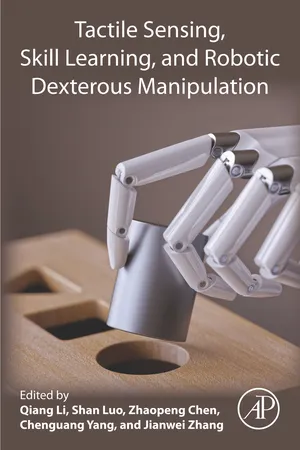
Tactile Sensing, Skill Learning, and Robotic Dexterous Manipulation
- 372 pages
- English
- ePUB (mobile friendly)
- Available on iOS & Android
Tactile Sensing, Skill Learning, and Robotic Dexterous Manipulation
About This Book
Tactile Sensing, Skill Learning and Robotic Dexterous Manipulation focuses on cross-disciplinary lines of research and groundbreaking research ideas in three research lines: tactile sensing, skill learning and dexterous control. The book introduces recent work about human dexterous skill representation and learning, along with discussions of tactile sensing and its applications on unknown objects' property recognition and reconstruction. Sections also introduce the adaptive control schema and its learning by imitation and exploration. Other chapters describe the fundamental part of relevant research, paying attention to the connection among different fields and showing the state-of-the-art in related branches.
The book summarizes the different approaches and discusses the pros and cons of each. Chapters not only describe the research but also include basic knowledge that can help readers understand the proposed work, making it an excellent resource for researchers and professionals who work in the robotics industry, haptics and in machine learning.
- Provides a review of tactile perception and the latest advances in the use of robotic dexterous manipulation
- Presents the most detailed work on synthesizing intelligent tactile perception, skill learning and adaptive control
- Introduces recent work on human's dexterous skill representation and learning and the adaptive control schema and its learning by imitation and exploration
- Reveals and illustrates how robots can improve dexterity by modern tactile sensing, interactive perception, learning and adaptive control approaches
Frequently asked questions
Information
Table of contents
- Cover image
- Title page
- Table of Contents
- Copyright
- Contributors
- Preface
- Part I: Tactile sensing and perception
- Chapter 1: GelTip tactile sensor for dexterous manipulation in clutter
- Chapter 2: Robotic perception of object properties using tactile sensing
- Chapter 3: Multimodal perception for dexterous manipulation
- Chapter 4: Capacitive material detection with machine learning for robotic grasping applications
- Part II: Skill representation and learning
- Chapter 5: Admittance control: learning from humans through collaborating with humans
- Chapter 6: Sensorimotor control for dexterous grasping – inspiration from human hand
- Chapter 7: From human to robot grasping: force and kinematic synergies
- Chapter 8: Learning form-closure grasping with attractive region in environment
- Chapter 9: Learning hierarchical control for robust in-hand manipulation
- Chapter 10: Learning industrial assembly by guided-DDPG
- Part III: Robotic hand adaptive control
- Chapter 11: Clinical evaluation of Hannes: measuring the usability of a novel polyarticulated prosthetic hand
- Chapter 12: A hand-arm teleoperation system for robotic dexterous manipulation
- Chapter 13: Neural network-enhanced optimal motion planning for robot manipulation under remote center of motion
- Chapter 14: Towards dexterous in-hand manipulation of unknown objects
- Chapter 15: Robust dexterous manipulation and finger gaiting under various uncertainties
- Appendix A: Key components of dexterous manipulation: tactile sensing, skill learning, and adaptive control
- Index